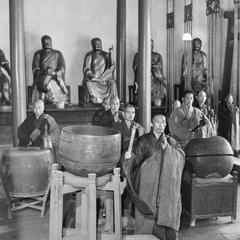Historians need evidence from the past to make their arguments effectively. The evidence historians use is often referred to as “primary sources.”
Primary sources are the building blocks of historical research - they are the documents or artifacts closest to the topic of investigation that you will use as evidence to support your interpretation of the past. Often they are created during the time period which is being studied (e.g. correspondence, diaries, newspapers, government documents, art), but they can also be produced later by eyewitnesses or participants (memoirs, oral histories). You may find primary sources in their original format--often in an archive--or reproduced in a variety of ways: published in books, on microfilm, or digitized in a searchable database.
Below are some tips for finding primary sources as well as some examples of online primary source collections relevant to East Asian history.
Primary sources are typically organized according to who created them.
When looking for primary sources, think about who would have documented the people, places, and events that interest you, keeping in mind that those documents might be written by participants, outside observers, or even opponents of your subject matter. This guide presents possible primary source materials first by source type, such as one person's papers (letters sent to colleagues, professional work, budgets), newspapers, or documents created by government agencies.
Our research projects might use a wide range of source types, but perhaps are limited to a particular place and time. Thus, this guide also offers further suggestions organized by geographic region.
With primary sources, the possibilities are endless.
This research guide is not a comprehensive list of primary source collections that might be relevant to your topic. Historians are constantly innovating in the way they use traditional sources and finding creative ways to work with new ones.
You are not alone. Ask an expert!
Research with primary sources is a collaborative effort. Experts in your field will know how resources have been used by other historians, and can help you to think creatively about what types of sources to use. Librarians and archivists are skilled at talking through your research project and connecting you to materials in their collections and beyond. And don't forget to consult the bibliographies and citations of other historians to get ideas on what sources to use (and where to find them).
Asahi Shimbun Cross-Search from the Asahi Shimbun Company is the largest newspaper article database in Japan. It includes 15 million articles and advertisements from more than 135 years of the newspaper, from its first edition in 1879 Meiji 12) to today. The database also contains articles from the magazines 'AERA' and 'Shukan Asahi', a Historical Photo Archive database of approximately 10 thousand photographic records mostly taken in Asia during the World War II period, an English-language News Database, Asahi Graph, Who's Who database, Image Database of Regional pages, and contemporary Dictionary Chiezo.
Abbreviation: kikuzo
Vendor: Asahi Shimbun Company
Coverage: 1879–Current
Type: Historical / Primary Sources, Newspapers and Newswires
People's Daily is the most influential and authoritative newspaper in China. It is the official voice of the central government of the People's Republic of China. For the last 70 years, the People's Daily has published daily issues that provide the single location where the central government and the Communist Party of China announce their respective policies and disseminate governmental, political, and economic messages to the public and the world. Most importantly, since its inception the newspaper has been the true barometer of the political climate of Chinese society. Access limited to 2 users.
Abbreviation: renmin
Vendor: Ori Probe Information Service
Coverage: 1946–Current
Subjects: Asian Studies, History
Type: Historical / Primary Sources, Newspapers and Newswires
For microfilm collections of Asian newspapers, do a subject search in the library catalog for "Country Name" and "Newspapers" (e.g. Japan newspapers). Many of these titles must be requested from the Center of Research Libraries which can be done directly from the FSU catalog record.
Abbreviation: snww2
Vendor: Adam Matthew Digital Ltd
Coverage: 1939–1948
Subjects: History
Type: Historical / Primary Sources, Newspapers and Newswires
Consider exploring the history of Asia, international relations, and the experience of Asian-Americans through major United States newspapers such as the New York Times or the Los Angeles Times. While the New York Times may provide deep coverage of relevant U.S. government policies and politics, the Los Angeles Times may provide better coverage of Pacific coast communities and have more sustained interest events abroad in Asia.
Always keep in mind the perspectives of journalists and their intended readers when using newspapers as primary sources.
Offers full-page images and article images from the New York Times newspaper from its first issue in 1851 to three years before the current date. This historical newspaper provides genealogists, researchers and scholars with online, easily-searchable first-hand primary source accounts and unparalleled coverage of the politics, society and events of the time.
Abbreviation: nythist
Vendor: ProQuest
Coverage: 1850–Current - 3 years
Subjects: History
Type: Historical / Primary Sources, Newspapers and Newswires
Provides comprehensive coverage for Southern California's largest daily newspaper, with full-text digital reproductions of every page, article, and issue in PDF format. In addition to news stories, editorials, letters to the editor, obituaries, birth and marriage announcements, photos, and advertisements are included. Current coverage: 1881–2001.
Abbreviation: lath
Vendor: ProQuest
Coverage: 1881–2001
Subjects: History
Type: Historical / Primary Sources, Newspapers and Newswires
For access to more historical newspapers, visit:



_B20107-12.png)
Manuscripts for the study of Meiji society, culture, ethnology, and education from the papers of Edward Sylvester Morse (1838–1925). Edward S. Morse was a great polymath notable for his work in natural history, ethnography, and art history, but perhaps most famous for his work in bringing Japan and the West closer together.
Abbreviation: mj
Vendor: Adam Matthew Digital Ltd
Coverage: 1856–1925
Subjects: Architecture, Art History, Asian Studies, Music
Type: Biographies, Historical / Primary Sources, Images, Indexes / Catalogs, Maps
© Florida State University Libraries | 116 Honors Way | Tallahassee, FL 32306 | (850) 644-2706